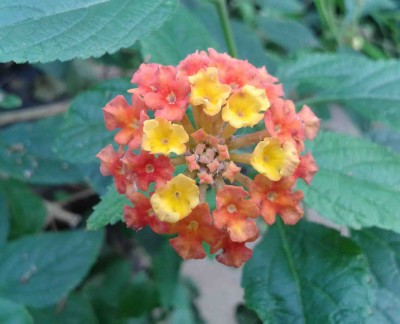During one of my first days of study for a masters degree in Plant Diversity at Reading University, we visited the Tropical Biodiversity Greenhouse. A pungent odour from a very brightly coloured plant came straight to my nose! The plant in question was Lantana camara.

Fig 1. Lantana camara shrubs, displaying different colours © Colin Clubbe, 2013 & © Sara Bárrios, 2013
We’ve covered a diverse range of plant families since then, but I now have the pleasure of returning to this most interesting plant. So, let me introduce you…

Fig 2. Lantana camara, showing the inflorescences (A) and the decussate leaf arrangement (B). © Sara Bárrios, 2013
Lantana camara L. is a shrub in the Verbena family (Verbenaceae)(1,5, 7), which is native to tropical and subtropical forests of the Americas, including the Caribbean. It was described by Linnaeus, hence the L. abbreviation after the name. The inflorescence (the flowering part of the plant)(4) is formed of flowers grouped in axillary heads. Each flower has four petals, which are almost fused. The dentate leaves are opposite and decussate (opposite pairs at right angles)(4) and, when crushed, are very fragrant. It also has square stems which are covered with hairs.(1)
Many colours for one single plant!
A fascinating feature of Lantana camara is that it has a multicoloured inflorescence, which can display yellow, red, purple, pink and even white flowers! But why are these plants putting so much energy into producing flowers of so many different colours? Is this an evolutionary response or just an aesthetic feature?
To answer this, we need to take a closer look. In the centre of the inflorescence, one can find lighter coloured flowers which are the first ones to open. These flowers contain pollen and aim to attract pollinators. As the flowers age, they start turning darker. These “older flowers” don’t have much pollen left. According to previous studies(2), the red flowers help to distract a stingless bee. The bee bites the bases of the stamens and takes the precious pollen of Lantana camara, but the plant doesn’t get any pollination service in return. This way, the bees will “attack” the red flowers, leaving the yellow flowers for the true pollinators which, in this case, are butterflies. So, it seems having multicoloured inflorescences is an evolution feature that helps the plant to attract the pollinator and, simultaneously, deceive the pollen thieves!(2, 6) Who says plants are not smart?
The image in Figure 4 illustrates the variety of colours that Lantana camara can produce. All three flowers, ranging from yellow to red, are from the same inflorescence as the plant in the photo of Figure 3.
A beautiful wildflower or a nasty weed?
In its native range, Lantana camara is much appreciated for its natural colours and the way it attracts butterflies. However, in countries such as Australia and certain parts of Africa it is categorised as a national weed and many programmes are in place for its eradication. Lantana camara grows and invades the understory of native forests, competing for water and nutrients. It stops the natural succession of native plants, impacting the biodiversity of the forests. It is also known to be toxic to stock. To remove it, the Australian Environmental Government, advices “a range of methods including herbicides, mechanical removal, fire, biological control and revegetation should be used”. Lantana camara has a huge economic and environment impact in countries where it is considered a weed.(3)
Even though it is a tropical plant, one can not exclude the possibility that it might become a problem in some warmer parts of Europe. In the photograph above (Fig 5.), Lantana camara is growing vigorously on the steps of Málaga Cathedral in Spain!
Not many plants can create such contrasting feelings as Lantana camara. It makes us think that, what can look like paradise for some, can be considered a real nightmare for others!
Further Reading
- USDA – Natural Resources Conservation Service
- Weeds in Australia (Australian Government)
- Weed management guide – Lantana camara
1. Acevedo-Rodríguez, P. (1996). Flora of St. John, US Virgin Islands. Bronx, New York: New York Botanical Garden.
3. Global Invasive Species Database
4. Beentje, H. J. (2010). The Kew plant glossary: an illustrated dictionary of plant terms. Royal Botanic Gardens Kew
5. Heywood, V.H., Brummitt, R.K., Culham, A. and Seberg, O. (2007). Flowering Plant Families of the world. Royal Botanic Gardens Kew. Journal of Experimental Botany, Vol. 35, N 0. 160, pp‘ 1656—1662
6. Mohan Ram, H.Y.; Mathur, G. (1984). Flower Colour Changes in Lantana camara. Journal of Experimental Botany, Vol. 35, N0. 160, pp‘ 1656—1662.
7. WCSP (2013). ‘World Checklist of Selected Plant Families’. Facilitated by the Royal Botanic Gardens, Kew. Published on the Internet; http://apps.kew.org/wcsp/ Retrieved 02/01/14.




It’s really unfortunate that a pretty plant smelling of ripe fruit can be so toxic. I noted a web page mentioning that the unripe fruit can be toxic to small children http://research.vet.upenn.edu/PoisonousPlantsofPA/LantanaCamara/tabid/5453/Default.aspx – luckily it does not seem to fruit at all readily in cultivation here.